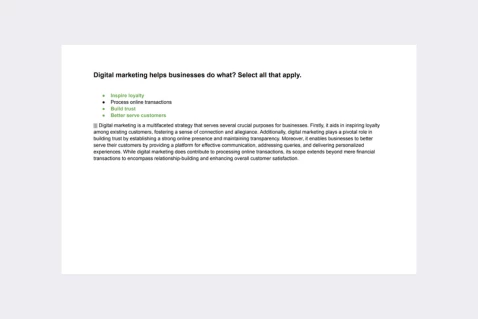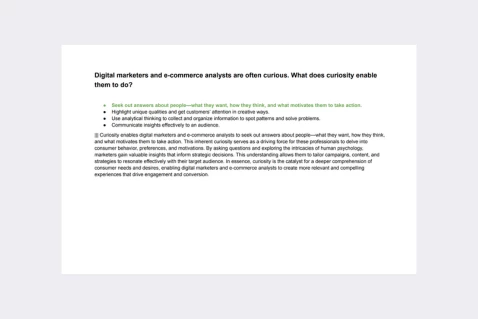A digital marketer interacts with users online to improve their experiences with a brand. They track conversations and trends related to the brand. What process are they using to determine what users think about the brand?
Social media planning
Data collecting
Social listening
Analytics tracking
Certification program: 👉 Google Digital Marketing & E-commerce Professional Certificate (Coursera)
Explanation: The digital marketer is using the process of “Social Listening” to determine what users think about the brand. Social listening involves actively monitoring and tracking online conversations, mentions, and trends related to a brand across various social media platforms. By engaging in social listening, the digital marketer gains valuable insights into the sentiments, opinions, and discussions surrounding the brand within the online community. This process goes beyond basic data collection and analytics tracking by focusing on understanding the qualitative aspects of user experiences and perceptions. It enables the marketer to respond to customer feedback, identify emerging trends, and make informed decisions to enhance the overall user experience and shape the brand’s online presence.
Passing exams is not a workout. Multiple attempts won’t make you stronger.



- All possible certificate program questions
- Real certification exam questions
- Detailed answer explanations.
- Over 1700 questions, 7 courses, 30 quizzes
- Free lifetime updates.
Understanding User Sentiment: How Digital Marketers Track Brand Perception Online
In the digital age, understanding how consumers perceive your brand is crucial for success. Every interaction, mention, and review online contributes to the overall sentiment surrounding your brand. Digital marketers employ various strategies to track and analyze user sentiment, allowing them to gain valuable insights and improve the customer experience. So, what process do they use to determine what users think about the brand?
The Process of Tracking User Sentiment
1. Social Listening
Social listening involves monitoring social media platforms, forums, blogs, and other online channels for conversations related to your brand. By tracking mentions, hashtags, and keywords associated with your brand, digital marketers can gauge public opinion and sentiment in real-time.
2. Sentiment Analysis Tools
Digital marketers utilize sentiment analysis tools to automatically analyze and categorize online mentions of their brand as positive, negative, or neutral. These tools use natural language processing algorithms to detect emotions and opinions expressed in text, providing valuable insights into overall brand perception.
3. Customer Surveys and Feedback
Directly soliciting feedback from customers through surveys, polls, and feedback forms is another effective way to gauge sentiment. Digital marketers can ask specific questions about customers’ experiences with the brand, products, or services to uncover insights and identify areas for improvement.
4. Online Reviews and Ratings
Monitoring online reviews and ratings on platforms like Google Reviews, Yelp, and industry-specific review sites offers valuable feedback from real customers. Digital marketers can analyze trends, identify common pain points, and address issues promptly to improve brand perception and customer satisfaction.
Practical Insights for Improving Brand Perception
-
Engage and Respond: Actively engage with users online by responding to comments, addressing concerns, and acknowledging positive feedback. This demonstrates attentiveness and a commitment to customer satisfaction.
-
Monitor Trends: Keep a pulse on emerging trends, topics, and conversations related to your industry and brand. Staying informed allows you to adapt your marketing strategies and messaging accordingly.
-
Identify Advocates and Influencers: Identify and nurture relationships with brand advocates and influencers who can positively influence brand perception and amplify your message to a wider audience.
-
Continuous Improvement: Use insights gathered from tracking user sentiment to inform strategic decisions and continuously improve the customer experience. Addressing pain points and implementing feedback demonstrates a commitment to customer-centricity.
In conclusion, tracking user sentiment online is a critical process for digital marketers seeking to understand and improve brand perception. By leveraging social listening, sentiment analysis tools, customer feedback, and online reviews, marketers can gain valuable insights into customer opinions, identify areas for improvement, and ultimately enhance the overall customer experience.
Now, armed with a deeper understanding of user sentiment, how will you tailor your marketing efforts to better resonate with your audience?
Discover our best-value guides
- Special Bundle Offer Google_Ads_Roll
- Special Bundle Offer HubSpot_Exams_Roll
- Special Offer Unchained_Guru_Roll
- Special Bundle Offer Amazon_Roll
- Special Bundle Offer Google_Analytics_Roll
- Special Bundle Offer Google_SkillShop_Roll
- Special Bundle Offer Marketing_Platforms_Roll
- Special Bundle Offer Microsoft_Advertising_Roll
- Special Bundle Offer YouTube_Roll
- Special Bundle Offer Google_Android_Roll
- Ultimate PMP certification preperation guide
- Google Cloud Professional Architect Certification Exam Answers - Ultimate Guide
- Special Bundle Offer SEMrush_Roll